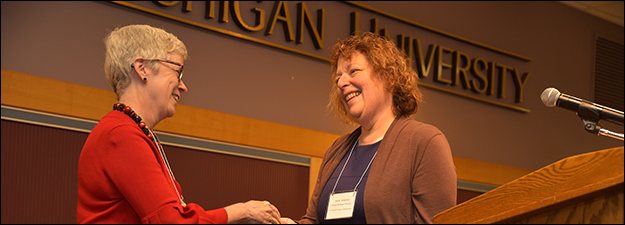Through a Medieval Looking Glass: Reading Eustache Deschamps's Miroir de mariage
Sponsoring Organization(s)
Special Session
Organizer Name
Deborah M. Sinnreich-Levi
Organizer Affiliation
Stevens Institute of Technology
Presider Name
Deborah M. Sinnreich-Levi
Paper Title 1
The Miroir de mariage and the Vernacular Debate between the Vita Contemplativa and Vita Activa
Presenter 1 Name
Margriet Hoogvliet
Presenter 1 Affiliation
Rijksuniv. Groningen
Paper Title 2
Reconstructing Female Voices to Speak about Women: A Comparison Between Eustache Deschamps's Miroir de mariage and Geoffroy de la Tour Landry’s Livre pour l'enseignement de ses filles
Presenter 2 Name
Delphine Mercuzot
Presenter 2 Affiliation
Bibliothèque nationale de France
Start Date
14-5-2017 8:30 AM
Session Location
Schneider 1355
Description
Eustache Deschamps' Miroir de mariage has vexed scholars for many years -- in part because editions are few and translations, non-existent. Although the poet has drawn increasing interest from the scholarly community as Deschamps students have expanded in the last 30 years, the Miroir remains relatively unexplored. Is it a serious debate poem? Is it an encyclopedic compendium? What explains the poet's widely divergent content?: densely mystical metaphorical visions of the rewards of Christian behavior; searing portraits of the manners of the bourgeois; reworkings of stock pieces from the Widow of Ephesus to Secundus the Silent; catalogs of fish and fowl; accurate [?] depictions of the odd behaviors of men and women of many classes. This session solicits essays to examine ways to read all or sections of the Miroir.
Deborah M. Sinnreich-Levi
Through a Medieval Looking Glass: Reading Eustache Deschamps's Miroir de mariage
Schneider 1355
Eustache Deschamps' Miroir de mariage has vexed scholars for many years -- in part because editions are few and translations, non-existent. Although the poet has drawn increasing interest from the scholarly community as Deschamps students have expanded in the last 30 years, the Miroir remains relatively unexplored. Is it a serious debate poem? Is it an encyclopedic compendium? What explains the poet's widely divergent content?: densely mystical metaphorical visions of the rewards of Christian behavior; searing portraits of the manners of the bourgeois; reworkings of stock pieces from the Widow of Ephesus to Secundus the Silent; catalogs of fish and fowl; accurate [?] depictions of the odd behaviors of men and women of many classes. This session solicits essays to examine ways to read all or sections of the Miroir.
Deborah M. Sinnreich-Levi

